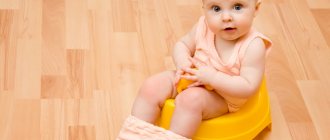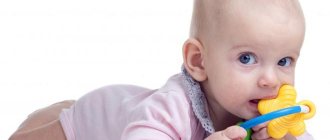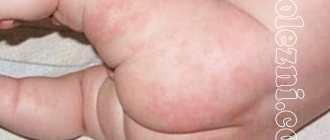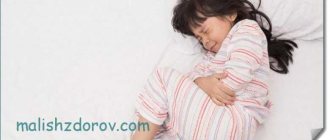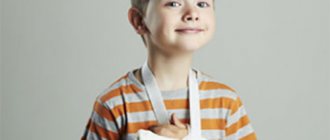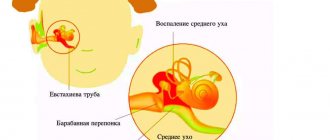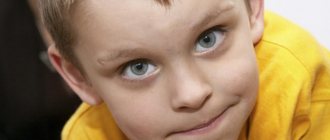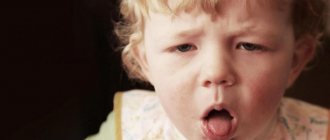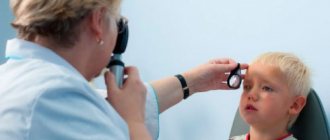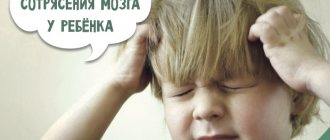Diarrhea in children 6 years old is a common occurrence. A child’s body at this age does not yet have strong immunity to various bacteria and this is the main cause of diarrhea. Let's look at the causes and methods of treating this disease.
Yellow diarrhea in a 6-year-old child can occur due to various factors. The most common of them is the entry of pathogenic bacteria or viruses into the body. Also, white diarrhea in six-year-old children can appear as a result of taking antibiotics. That is why, when taking them, medications are recommended to normalize the intestinal microflora and replenish the fluid balance in the body. Another of the most common causes is dysentery. Frequent diarrhea in a six-year-old green child should be a signal to show him to the doctor and undergo the necessary tests. The pediatrician will prescribe the correct treatment according to the etiology of the disease.
Symptoms of diarrhea in children
Diarrhea can be identified by the following signs:
- abdominal pain;
- loose stools repeated several times a day;
- increased gas formation;
- lack of appetite;
- lethargy;
- nausea;
- sweating
Diarrhea is dangerous due to dehydration. If loose stools are accompanied by vomiting, this process accelerates. Symptoms of the body losing fluid are: weight loss, dry mouth, infrequent urination and dark urine, lack of tears when crying. Therefore, if you do not know how to treat diarrhea in a six-year-old baby, remember to constantly drink plenty of fluids.
Securing the chair
There are specialized drugs for diarrhea that work at the receptor level.
In other words, they suppress the activity of the muscular walls of the rectum, which leads to the disappearance of the urge to defecate. The main advantage of such medications is their speed of action. They are indispensable if you need to eliminate diarrhea immediately. Popular medications to stop diarrhea are Loperamide and Imodium. Both products are available in tablet form. Antidiarrheal drugs should not be used if the child is under 4 years of age. If the baby is older, then the use of drugs is allowed only under the supervision of a pediatrician. A mother who has given this medicine to her child needs to be closely monitored to ensure that no side effects develop. If allergic rashes, abdominal pain or constipation appear, it is important to show your baby to a specialist.
Loose stools in a 6 year old child, treatment
Your six year old has diarrhea and you don’t know what to do? Does it not go away within two days and has all the signs of dehydration? Contact your doctor immediately. If the baby’s condition is satisfactory, you can use the following tips on how to stop diarrhea in a 6-year-old child:
- After each trip to the toilet, wash your baby to avoid irritation;
- do not force your baby to eat if he has no appetite;
- let's drink more saline solutions (special drugs are sold in pharmacies: rehydron, glucosolan, etc.);
- measure the temperature. If it starts to rise, call a doctor at home;
- If a six-year-old child has diarrhea, and you don’t know how to treat it, you can give the baby smecta and activated carbon or their analogues. Do not give your child any other medications unless prescribed by a specialist;
- think about what the baby ate the day before, which could have become a source of infection.
For the treatment of diarrhea, the doctor usually prescribes diarrhea medications for children 6 years of age, such as enterofuril, imodium, loperamide, and adiarine. The latter helps not only to cope with loose stools, but also to normalize the fluid balance in the body. You can use traditional methods of treating diarrhea:
- decoctions from the collection of fennel, oak bark and sage (1 tbsp. collection, all in equal quantities) infuse in 200 ml. cook for 15 minutes. Then strain, cool and give the baby 3 times a day, half a glass per appointment;
- A good remedy for diarrhea for a 6-year-old child is dried blueberries and bird cherry in a ratio of 2:3. Take a tablespoon of berry mixture and pour a glass of water and boil for 20 minutes. Take ¼ cup three times a day.
When your child wants to eat, do not refuse him, but try to follow a diet. Eliminate fatty, smoked, fried foods, as well as gas-forming foods from your diet. Give him rice and oatmeal porridge, blended soups, jelly, omelette, boiled and steamed vegetables, blueberries and lingonberries, lean steamed meat and fish.
And they have experience in treating this disease. But what to do if you encounter diarrhea in your baby for the first time? The main thing is not to panic! This article is a practical guide that answers the question “How to treat diarrhea in a child?”
So, if a child has loose stools without impurities and blood once or twice a day, while the temperature is not elevated and the stomach does not hurt, then there is no need to sound the alarm. You should give your child food that strengthens you a little: rice porridge, jelly with rice water (meaning that the water in which the rice was cooked should be sweetened and given to the baby), lean meat, potatoes, blueberries (dried, which are sold at the pharmacy), pears. If the trouble doesn’t happen again, you can relax.
If it happens more than 4 times a day and has an uncharacteristic color (black, green, or completely colorless), then you should be wary. And if blood is repeatedly present in the stool, then this is an extremely alarming sign, as is an increase in temperature. Especially if this happens to a child under 1 year old. In this situation, you should call a doctor. But, while waiting for the doctor to answer the question “How to treat diarrhea in a child?” You shouldn’t be idle. You should periodically measure the temperature and give the child frequent, but little, water to avoid dehydration. In this case, you should not drink water, because it will not linger in the intestines, but with special solutions, for example, “Regidron”, which is suitable even for children under 1 year old (but the dosage should be checked with a doctor!).
A separate “song” is the child’s color against the background of teething, and the stool seems to “squirt” out. This, of course, looks scary. But, as a rule, it ends with the appearance of the tooth. However, you should definitely consult a doctor!
By the way, in children in the first month of life, stool can happen 10 times a day - this is not a pathology if the stool does not foam, has a normal color and does not have a pronounced unpleasant odor.
It is important to know that you should not stop breastfeeding if a child has diarrhea: breast milk contains substances that help normalize intestinal flora.
It is good to have the following drugs on hand: Smecta, Linex, Nifuroxazide. They can be used as an “ambulance” by consulting with your doctor about the dosage while waiting for the doctor to arrive.
If diarrhea lasts more than 3 days, then it is worth taking tests that will confirm or refute the presence of infection (diarrhea can be a symptom of diseases such as dysentery, salmonellosis, Shigella Zone). Diarrhea can also be caused by dysbacteriosis, which tests will also help identify.
But what to do if the illness manifested itself suddenly and far from home, for example, during a vacation outside the city? Parents are tormented by the thought “How to treat diarrhea in a child?” If there is no pharmacy nearby and the parents did not take medications with them, then you should prepare the following solution: dissolve 1 tablespoon of sugar, half a teaspoon of baking soda and 1 teaspoon of table salt in 1 liter of boiled water. This is a fairly effective remedy for diarrhea for children. But it is not a panacea, but a temporary measure! You should consult a doctor immediately! At the very least, consult by phone!
It is worth noting that diarrhea in a child can be caused by a variety of reasons and you can passively wait for improvement or self-medicate; in no case should you “prescribe” antibiotics to your child - this can cause the most dire consequences. So, summarizing the answers to the question “How to treat diarrhea in a child?”, we get the following list of actions: call a doctor and, while waiting for him, give the child a drink (Regidron or its analogues), monitor all changes in the baby’s behavior and condition.
The gastrointestinal tract of a child and an adult has a number of physiological and anatomical differences. The baby’s digestive system is not able to break down the vast majority of food products due to a lack of enzymes necessary for this. The child's body has not yet learned to effectively fight infections and viruses. Therefore, diarrhea in children is a common occurrence at an early age.
Diarrhea is unlikely to go unnoticed. Loose stools and frequent urge to defecate are a sure sign that the child’s digestion is impaired, and appropriate measures must be taken to eliminate this undesirable phenomenon.
Diarrhea is often expressed by the following symptoms:
1. Loss of appetite. During illnesses associated with digestive disorders, children often refuse to eat. This is a protective reaction of the body caused by the need to reduce the load on the gastrointestinal tract.
2. Nausea, vomiting and diarrhea often accompany each other. Vomiting can be single or repeated (over several hours). Sometimes it is associated with food or liquid intake.
3. Diarrhea and fever in a child are very dangerous symptoms. They can signal the presence of an intestinal infection in the body. In some cases, the temperature rises due to colds, and diarrhea is only a side effect of hyperthermia.
4. Changes in the smell and color of stool are associated with digestive disorders. With inflammatory bowel diseases and dysbiosis, the stool darkens. Hepatitis, cholecystitis, and cholera cause discoloration of feces and a foul odor.
5. If children have diarrhea with mucus and impurities of pus or blood, this should alert parents. Such symptoms are characteristic of some pathologies that need to be treated in a hospital.
6. Pain in the abdominal area of varying intensity. They can be aching, cutting or stabbing in nature. They can be constant or cramping. The pain syndrome may appear along with the urge to defecate or with bloating and decrease after the release of gases and feces.
7. Weakness and lethargy indicate the onset of dehydration (dehydration) of the body. Significant fluid losses occur when a child has water diarrhea and vomiting.
Children often suffer from diarrhea; this is due to imperfections in the digestive, nervous and immune systems of the body. Diarrhea is often accompanied by teething, colds, introducing a new product to the diet, or overexcitement. In this case, you can cure the baby yourself.
If diarrhea does not have additional symptoms and is short-lived, there is no need to panic. In case of prolonged digestive disorders (2 or more days) and serious changes in the characteristics of stool and general condition, consultation with a pediatrician is necessary.
Why is severe diarrhea dangerous in children?
Together with feces, a large amount of fluid is removed from the body. Dehydration is especially dangerous at an early age. A child's body is 98% water and loses it much faster than an adult. Having lost 15% of body weight due to severe watery diarrhea, a person can die. This means that with a weight of 10 kg, the critical volume of fluid loss is only 1.5 liters. Diarrhea and vomiting can remove this amount of moisture from the body in a few hours.
Dehydration has several stages, each of which is expressed by certain symptoms.
- 1st degree – fluid loss up to 5% of body weight;
- 2nd degree – up to 9%;
- Grade 3 – fluid deficiency over 15%.
When a child vomits and has diarrhea, the body loses not only water, but also vital microelements. Dehydration is classified according to the ratio of salt and fluid losses (water deficiency, salt deficiency, isotonic).
Water deficiency dehydration (hypertensive) has the following symptoms:
- strong thirst;
- dry mucous membranes (lips are cracked, there is no saliva, eyes are sunken);
- small amount of urine;
- lack of tears;
- dry, rough skin;
- dyspnea.
This type of dehydration occurs with severe watery diarrhea in children with fever and moderate vomiting.
Salt deficiency dehydration (hypotonic) is characterized by:
- lethargy, lethargy;
- lack of thirst;
- sunken fontanel (in infants);
- frequent, weak pulse;
- low blood pressure;
- cold, damp, marbled skin;
- convulsions;
- hiccups.
With catastrophic fluid loss, diarrhea stops, gases stop passing, respiratory failure and cerebral edema develop. This type of dehydration is characterized by mild diarrhea accompanied by intense, repeated vomiting unrelated to food or liquid intake. The temperature remains within normal limits or drops slightly.
Isotonic dehydration combines moderate symptoms of the two previous types and is characterized by an equivalent loss of water and electrolytes. This is the mildest type of dehydration.
Possible causes of diarrhea in children
1. Prolonged diarrhea, accompanied by abdominal pain during bowel movements and while eating, is a symptom of Crohn's disease. There is also loss of appetite, weight, nausea, vomiting, flatulence, and blood in the stool. Children suffering from this disease are developmentally delayed and their metabolic processes are disrupted.
2. Acute intestinal infections (salmonellosis, dysentery, rotavirus infection) are manifested by an increase in temperature. Vomiting appears, independent of food intake. In infections of viral etiology, the stool is watery. In case of bacterial infection – with admixtures of mucus and foam. The feces acquire a pungent odor and the color of the stool changes. Abdominal pain is cramping.
3. Liquid stool (sometimes with pieces of undigested food) without foreign impurities after taking medications or a product unfamiliar to the body indicates an allergy.
4. Food poisoning is accompanied by nausea and vomiting after eating. The stool has an unpleasant, pungent odor and may contain blood. Abdominal pain is spasmodic and severe. Doesn't get better even after diarrhea and vomiting stop.
5. Abundant fatty feces (steatorrhea), containing pieces of undigested food, decreased appetite and pain in the navel indicate the presence of enteritis (inflammation of the small intestine).
7. Dysbacteriosis causes loose, foamy stools with a sour or putrid odor. Children lose their appetite and a white coating forms on the tongue. Skin rashes and flatulence may appear. Pain (colic) occurs between meals. Probiotics help cure dysbiosis.
8. In rare cases, diarrhea is caused by an attack of appendicitis or overheating of the body. An infant will not be able to explain what is bothering him. Therefore, it is necessary to treat severe diarrhea in young children under the supervision of a specialist.
9. Diarrhea without fever can be a consequence of nervous disorders, decreased immunity, inflammatory diseases of the intestines or stomach, allergies, poisoning, dysbacteriosis or poor diet.
Therapy for infants
At the very beginning of life, the human body is able to digest only a certain type of food (milk). During this period, the intestines empty themselves up to 8 times a day. Liquid feces without foreign impurities and odor are considered normal in breastfed children and do not require treatment. In some cases, the stool has a greenish color, which also should not be a cause for concern (up to 7 - 8 months). This is due to the presence of bilirubin in them. The stool may contain a small amount of mucus.
Parents should be alert to diarrhea, accompanied by profuse vomiting and fever, changes in the color and smell of stool, foamy feces and impurities of blood or pus in it. In this case, you need to urgently see a pediatrician. He will assess his condition and prescribe adequate treatment or recommend hospitalization. Before the doctor arrives, it is important to prevent dehydration, which occurs very quickly at this age and can be fatal. To do this, you need to give your baby water as often as possible.
It is better to treat dehydration with solutions of Regidron or Gastrolit. They are sold in powder form at pharmacies. They are dissolved in 1 liter of water and given in small portions (5 - 10 ml) every 10 minutes. If diarrhea is accompanied by severe vomiting, the liquid is administered dropwise from a pipette. If it is not possible to purchase a ready-made drug, you can prepare the solution yourself. To do this, just dissolve 2 tbsp in 1 liter of water. l sugar and 1 tsp each salt and soda.
Rehydrating drugs do not affect stool consistency, do not stop diarrhea, and do not treat pathologies that cause diarrhea. They only replenish the deficiency of microelements and fluid in the body. The only medicine that can be given to a baby with loose stools on its own is Smecta. It is completely safe, is not absorbed in the intestines and is completely eliminated from the body. Smecta is recommended for eliminating diarrhea at any age. It has an enveloping effect and does not harm beneficial microflora. Smecta absorbs pathogenic microorganisms and their metabolic products, toxins and allergens and removes them from the body.
Other remedies for diarrhea in infants should be used only on the recommendation of a pediatrician.
Treatment of children over 1 year of age
Fluid loss in children over one year of age is no less dangerous than in infants. Therefore, the procedure of dehydration of the body is the first priority measure at the first suspicion of dehydration. This is especially important if the diarrhea is watery and accompanied by vomiting and fever.
1. In the treatment of digestive disorders in children who have emerged from the infant period, you can use (in addition to Smecta) Enterodes, Enterosgel, Polysorb PM. Preparations such as Karbolen, Microsorb-P, Filtrum and Activated Carbon have a similar absorbent effect, but they are less effective.
2. Complex therapy for loose stools must include pro- and prebiotics. They contain living microorganisms of beneficial microflora and substances that stimulate their growth. Recommended for children: Bifiform Baby, Bifidumbacterin, Enterol, Eubicor, Hilak Forte.
3. Severe diarrhea that cannot be cured in 2 days disrupts digestion. A sign of this is a foul odor, flatulence, pieces of undigested food in the feces, and a coating on the tongue. In this case, enzymes are prescribed.
4. Before choosing such remedies, a stool analysis is done. This helps to find out the exact cause of the disorder, after which one of the enzyme preparations (Pancreatin, Mezim Forte, Pangrol 400) is prescribed.
5. Diarrhea is often expressed by paroxysmal pain in the abdominal area. Antispasmodics (No-shpa, Drotaverine, Spasmol, Plantex, Iberogast) can alleviate suffering.
6. Diarrhea may require treatment with local and systemic antibiotics (Amoxicillin, Amoxiclav, Ercefuril, Enterofuril). They should only be recommended by a doctor.
7. Based on the results of stool examination, if a bacterial infection is detected, bacteriophages are prescribed. These are artificially created viruses that only infect pathogenic bacteria.
Drugs such as: Diarol, Lopedium, Imodium, Enterobene are contraindicated in the treatment of digestive disorders in children.
Features of the diet
If a child has diarrhea, you should go on a starvation diet for some time. This does not apply to infants. With milk or formula, they receive the fluid the body needs, so there is no need to stop feeding. Older children can be temporarily limited in food (from 10 to 24 hours depending on age). At this time, you need to give a lot of liquid (tea, mineral water without gases, chamomile decoction). Then they switch to rice water and white bread croutons. Feed in small portions, 6 – 7 times a day. Other products recommended for digestive disorders and age-appropriate are gradually introduced.
During diarrhea, children often lose their appetite and completely refuse food. There is no need to force feed; his body will tell him when food is needed. If he feels hungry, you can give:
- boiled potatoes without oil;
- boiled rice;
- bananas;
- stale white bread;
- steamed chicken breast cutlets;
- boiled fish (low-fat);
- baked apples (without peel);
- chicken broth soup;
- dried fruit jelly.
Food should be prepared without adding spices or oil and served warm in small portions. You should not overfeed if you have loose stools. It is better to give food more often than to increase the portion.
After diarrhea stops, you need to gradually switch to a normal diet. It’s better to start with fermented milk products (fresh cottage cheese, kefir, fermented baked milk). Then add porridge with a little butter. You can fully return to your usual diet in 1–2 weeks.
Loose stools in a baby under one year of age are considered normal, since he is fed with breast milk. And this misleads many parents. They simply do not know how diarrhea occurs in children under one year old.
Causes of diarrhea
There are several causes of diarrhea in an infant under one year of age:
- Drinking too much breast milk can lead to indigestion. This is especially true for babies who are bottle-fed.
- Diarrhea in a child under one year of age occurs due to the predominance of fatty foods in the diet of a nursing mother.
- Complementary feeding can be given to the baby no earlier than after 6 months.
- Some children do not have enough lactase enzyme to digest milk sugar. Lactose deficiency causes foam in the stool.
- After treatment with antibiotics, the baby's microflora is disrupted and dysbacteriosis develops.
- The cause of diarrhea in children under one year of age may be an allergic reaction that occurs in an infant after consuming a new formula.
- . The child's gums become swollen and profuse salivation begins.
Diarrhea in a child
If your child has diarrhea, you should consult a doctor.
Children suffer from functional intestinal disorders almost more often than adults.
At the same time, treatment of diarrhea in children usually requires a more detailed and attentive medical approach.
How do you understand that a child is experiencing digestive problems and it’s time to show him to the doctor? To determine whether your child’s stool is normal, it is enough to remember the age norms regarding the frequency and specificity of bowel movements in children:
- up to 1 year – evenly loose stools (no more than 10 sessions per day), not accompanied by signs of dehydration;
- 1-2 years – more or less formed feces (no more than 4 or 5 bowel movements per day);
- 2-3 years – fully formed, soft feces without impurities (no more than 5 acts of defecation during one day).
Any deviations from the described characteristics in the direction of liquefied stool or increased urge to defecate can be considered characteristic symptoms of childhood diarrhea, which in itself is a reason to take your baby to the pediatrician.
The only exception is diarrhea that occurs when a child is teething. In these cases, diarrhea, accompanied by an increase in general body temperature, usually does not last longer than a day or two and goes away on its own, without any outside intervention.
Read: For little bellies: what can you give your child for diarrhea?
In all other cases, diarrhea in a child will most likely be caused by one of the following reasons. Among them it is worth highlighting the following:
- unhealthy diet (“spoiled” by the mother’s incorrect diet, breast milk, complementary foods introduced at the wrong time, a violent allergic reaction to some
- a specific product, an excess amount of fiber in the baby’s diet, etc.);
- excessive “infatuation” with medications (especially antibiotics and anti-inflammatory drugs, drugs based on bile acids, as well as
- medications with a pronounced laxative effect);
- damage by the causative agent of acute intestinal infection (viral, bacterial, parasitic or even fungal origin);
- insufficient level of secretion of digestive enzymes in the baby’s body;
- functional disorders of the biliary tract in a particular child (dyskinesia);
- the influence of negative environmental factors (for example, sudden changes in weather or even climatic conditions);
- nervous disorders (severe stress, regular emotional stress, etc.);
- disturbances of normal natural motility of certain parts of the intestine.
What are the features of a children's chair?
The newborn is fed breast milk. His stool is runny and may contain white lumps. As the baby grows, the consistency becomes thicker.
Bowel movements can occur 5 times a day. You should not compare the stool of an adult and a child. The baby eats mainly liquid food. With such a diet, his feces cannot be dense. The frequency of stool depends on the nature of the diet and the amount of digestive enzymes.
An alarming symptom is the appearance of mucus and foam in the stool. During bowel movements, the baby should not show anxiety. The baby's stool becomes dense only after the introduction of complementary foods.
Diarrhea during artificial feeding
Unlike breast milk, formulas do not contain substances that promote the growth of normal microflora and protective immunoglobulins, which are contained in breast milk.
In newborns, enzyme activity is sharply reduced. This complicates the process of digesting food. Fat breakdown takes a particularly long time. In breast milk, fat is in a simpler form, which is much better absorbed in the baby's body.
Artificial formula uses fat from cow's milk. But babies’ bodies lack lipase. Deficiency of this enzyme leads to disruption of the digestion process of artificial formula.
The risk of diarrhea in children is much greater than in adults. The reason lies in the anatomical features of babies. The intestines do not have sufficient protection to prevent the development of pathogenic microorganisms. Toxins and microbes easily penetrate into the mucous membranes.
When do we talk about diarrhea?
A newborn baby's intestines have a different structure than an adult's. It is longer and has a slightly higher tone. The intestinal microflora is also different: there are not so many beneficial bacteria in it, and the enzymes are not active enough to cope with the load. For this reason, digestive disorders under the age of 3 years are common. An infant's stool may be mushy, but this is considered normal.
The consistency and frequency of stool in children under one year of age depend on the type of diet. In infants up to 3 months, bowel movements may occur after each feeding, and the stool may be loose. As they grow, the number of bowel movements decreases, and after the introduction of complementary foods, the feces thicken.
It is considered normal if by the age of one year infants go to the toilet 1-2 times a day. Infants under one year of age who eat formula have bowel movements less often, and their stool is denser and darker.
Diarrhea is considered to be loose stools, the frequency of which exceeds 5 times a day. The color, density and smell of stool depend on the cause of the diarrhea.
Signs of dehydration
Intense diarrhea in a child under one year old leads to instant dehydration of the child's body. It is unlikely that it will be possible to compensate for the loss of fluid with ordinary water. Liquid does not remain in the body of a sick baby.
It is important for parents to be able to understand in time that their baby is developing dehydration. Symptoms of this condition include:
- Diarrhea in children under one year of age leads to permanent weight loss.
- The baby becomes lethargic and asks to be held.
- The baby's urge to urinate becomes less frequent. The urine becomes darker.
- The fontanel becomes retracted and the skin loses its elasticity.
- The baby practically does not produce saliva and has a dry mouth.
- The baby cries without tears because there is not enough fluid in his body.
Treatment of diarrhea in children before the Great Dane
If you have diarrhea, you should not stop feeding your baby. depends on the baby's nutrition.
For bottle-fed infants, you can select special mixtures with a therapeutic effect. They help restore the functioning of the digestive system.
Breast milk contains substances that protect the baby from various infections. It creates favorable conditions for the growth of healthy microflora in the baby's intestines.
To stop artificial diarrhea, you need to purchase a mixture with bifidobacteria.
During this period, a nursing mother should not eat foods that have a laxative effect. To eliminate mild dehydration, you can use still mineral water.
In more complex cases, it is necessary to use ready-made solutions. A child suffering from dehydration complains of dry mouth and headache. The skin becomes very dry and loses its former elasticity. The baby constantly asks to drink because he cannot compensate for the loss of fluid.
To do this, add half a teaspoon of salt and 8 teaspoons of sugar to boiled water. To prevent your baby from refusing to take the solution, it is advisable to add mashed banana to it.
What to do if indigestion occurs due to food intolerance?
The digestive system cannot instantly adapt to digest new ingredients.
Congenital pathologies can disrupt the baby’s digestive process. Deficiency of essential enzymes can lead to the following diseases:
- A sign of celiac disease is the inability to digest cereals.
- Many babies have difficulty digesting lactose. Such children should not be fed dairy products.
How to treat infectious diarrhea
A baby at this age is practically defenseless against harmful bacteria. Infections such as E. coli, dysentery, salmonellosis and typhoid fever pose a danger to a child.
Infectious diarrhea can be identified by the following signs:
- the child suffers from vomiting;
- his temperature rises sharply;
- profuse diarrhea occurs;
- he suffers from excess gas formation;
- the baby does not want to eat and begins to lose weight.
Parents should take the child to the hospital immediately. Babies under one year old are very difficult to tolerate infectious diseases. In such a situation, treating diarrhea at home can only worsen the child’s condition.
Treatment of the disorder with traditional methods
Be sure to consult your doctor before starting treatment with herbal infusions.
Linden blossom has long been used as a bactericidal agent. To prepare linden decoction, pour 1 tbsp. a spoonful of flowers with a liter of boiling water. The solution should be infused for 40 minutes. The product will not harm even a newborn. Diarrhea should stop within 12 hours after starting treatment.
You can also get rid of diarrhea with the help of aspen buds. Pour 30 grams of raw material into a liter of water and cook over low heat for 30 minutes. The cooled infusion must be passed through cheesecloth. The decoction should be given to the child 1 tbsp. spoon 3 times a day before meals.
It is considered the safest remedy for diarrhea. Rinse a spoonful of cereal with cold water. Bring a liter of water to a boil and add rice to it. The decoction can be used at any age, regardless of the cause of the disease.
A decoction of rose hips has a healing effect. To prepare the infusion, you need to pour 50 grams of dried fruits with 4 cups of boiling water. Close the container with a lid and wait for an hour. The child should be given a decoction of 100 ml 30 minutes before meals.
A child has diarrhea, what to do? Most often young and inexperienced parents panic. Diarrhea or diarrhea is the bowel movement (single or multiple) of liquid stool. Diarrhea occurs when the body needs to get rid of harmful or dangerous substances, such as pathogens.
If loose stools happen once, then don’t panic, just check what the child ate before.
But if this happens several times a day, and the baby has abdominal pain and vomiting, then you should consult a doctor, as this condition may indicate an intestinal infection.
